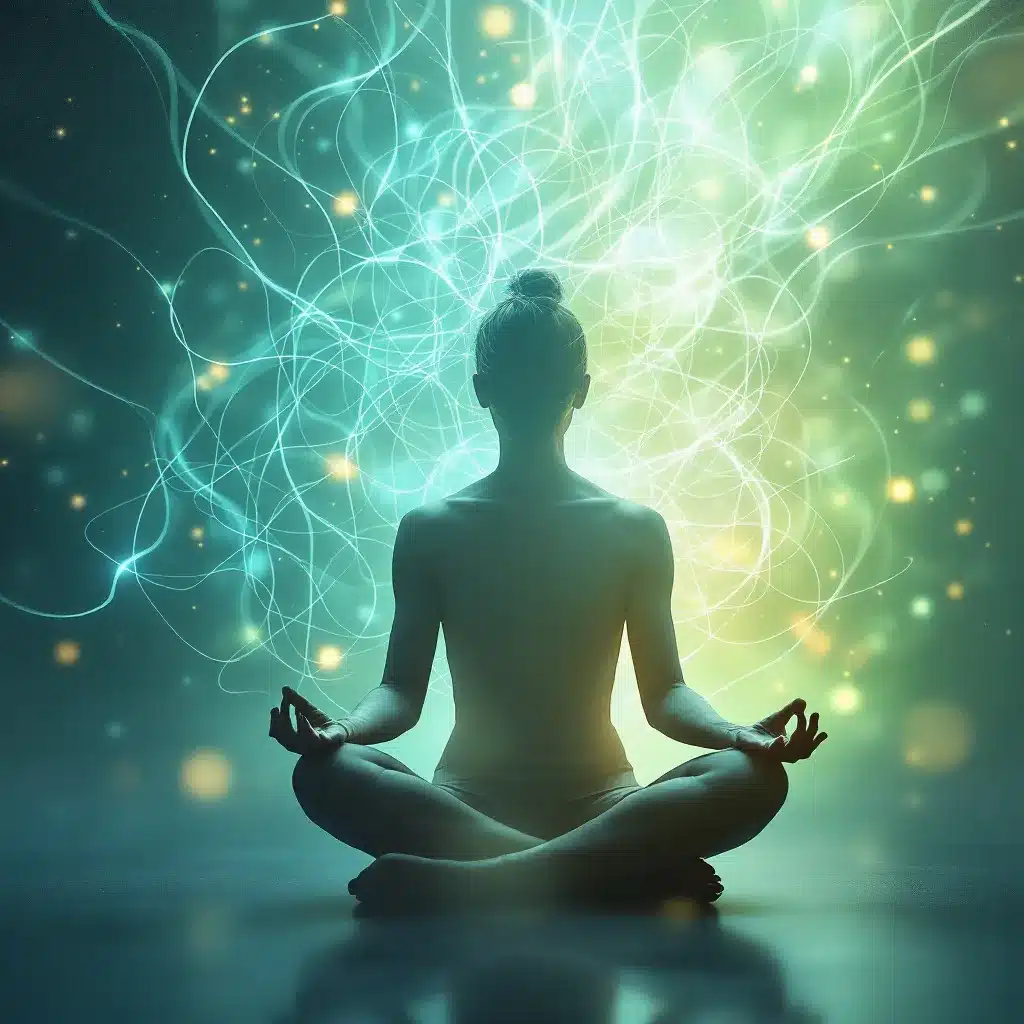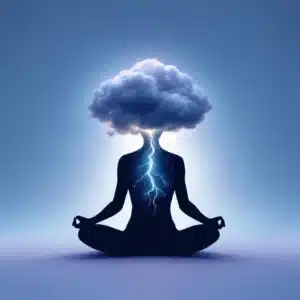Understanding Anxiety Symptoms: A Mindfulness Approach

That sudden racing heart. The tightness in your chest. That wave of dread that washes over you out of nowhere… Sound familiar? If you live with anxiety, you know these feelings all too well.
But what if you could change your relationship with them? What if, instead of seeing them as chaotic enemies to be crushed, you started seeing them as signals? Because that’s exactly what they are. These aren’t just random, uncomfortable sensations; they are your body’s way of talking to you. And learning to listen is the first, most powerful step toward finding your peace again.
That’s exactly what we’re here to do. We’re going to look past the clinical labels and get real about the physical, mental, and emotional anxiety symptoms you might be experiencing, helping you finally understand what your body is trying to tell you. When you learn to observe these signals without judgment, you can start to navigate them instead of letting them control you. And yes, we’ll also get into that super common (and frustrating) question: can anxiety symptoms really change from one day to the next? (Spoiler alert: they absolutely can.)

Recognizing the Physical Signs of Anxiety
So often, we talk about anxiety like it’s purely a battle of the mind—a storm of racing thoughts and endless worries. And while it’s certainly that, it’s so much more. Anxiety isn’t just “in your head”; it’s a full-body experience.
Think of it this way: your body’s ancient fight-or-flight response, the one designed to save you from immediate danger, is getting tripped by modern-day stressors like deadlines, traffic, and tough conversations. The result is a cascade of very real, and often very scary, physical anxiety symptoms. Getting to know these signals is the first step toward turning down the alarm.
Here are some of the most common ways anxiety shows up physically:
- Racing Heart or Palpitations: That sudden feeling that your heart is trying to pound its way out of your chest? Or maybe it feels like it’s fluttering, skipping a beat, or just racing for no reason. This is a classic sign. When your brain senses a threat, it floods your body with adrenaline, telling your heart to pump blood faster to get your muscles ready for action. It’s unsettling, for sure, but it’s just your body’s alarm system doing its job.
- Shortness of Breath: Ever feel like you just can’t get a full, satisfying breath? That tightness in your chest can lead to shallow, quick breathing (hyperventilation), which then makes you feel dizzy or lightheaded. It’s a frightening feedback loop, but it starts with that initial anxiety signal.
- Muscle Tension and Aches: Are your shoulders practically permanent earrings? Is your jaw always clenched? When you’re anxious, your body tenses up, bracing for a threat that never comes. For many people with anxiety, this becomes a chronic state. This constant tension can lead to stiff necks, tension headaches, and just a general feeling of being sore and exhausted.
- Digestive Issues: There’s a reason they call the gut our “second brain.” The connection between your mind and your digestive system is incredibly strong. When your mind is churning with worry, your stomach often pays the price. This can look like nausea, cramps, that “butterflies” feeling, diarrhea, or constipation. For many, digestive upset is one of the most disruptive physical anxiety symptoms.
- Sweating, Trembling, and Shaking: That sudden, clammy sweat when you’re not even hot? Or those uncontrollable shakes in your hands or legs? That’s pure adrenaline. It’s your body burning off a huge surge of nervous energy, getting you ready to move.
- Dizziness and Lightheadedness: All those changes in your breathing and heart rate can temporarily throw off the oxygen and carbon dioxide levels in your blood. The result? A dizzy, unsteady feeling, or even the scary sensation that you might pass out.
Learning to see these physical signs for what they are—your body’s overzealous attempt to protect you—is incredibly empowering. Instead of fearing the symptoms themselves, you can see them as a tap on the shoulder, a signal that it’s time to use your coping tools to help your nervous system stand down.
Unpacking the Mental and Emotional Symptoms of Anxiety
While a racing heart or shaky hands are easy to spot, the real war is often fought silently, inside our own minds. The mental and emotional anxiety symptoms can be the most draining of all, casting a shadow over every thought, feeling, and decision. Getting to know this internal landscape is key to understanding the full picture of anxiety.
Let’s pull back the curtain on some of the most common experiences.
Constant, Excessive Worry
This isn’t your average, everyday concern. This is a relentless, looping track of “what ifs” that you just can’t seem to turn off. For someone with anxiety, worry can feel like a default setting, latching onto anything and everything—your health, your job, your relationships, even tiny daily tasks.

It often leads to catastrophizing, where your mind instantly leaps to the worst-possible scenario. A friend doesn’t text back right away? It’s not because they’re busy; your anxious brain convinces you something terrible must have happened. This constant mental forecasting of doom is utterly exhausting.
Racing Thoughts and an Inability to “Switch Off”
Does your mind ever feel like a web browser with 100 tabs open at once, all playing different videos on full volume? That’s racing thoughts. It’s a chaotic flood of ideas, fears, memories, and to-do lists that jump from one to the next without any rhyme or reason. This mental “hamster wheel” makes it nearly impossible to concentrate, relax, or fall asleep, leaving you feeling scattered and perpetually on edge.
A Pervasive Feeling of Dread or Apprehension
Fear is usually tied to something specific. Dread, on the other hand, is anxiety’s vague, free-floating cousin. It’s that heavy, unsettling feeling that something bad is about to happen, even when everything seems fine. This sense of impending doom can hang over you like a dark cloud, stealing the joy from good moments and turning a beautiful day into a waiting game for the other shoe to drop.
Irritability and Difficulty Concentrating
When your nervous system is stuck in overdrive, your patience wears paper-thin. It’s common for people with anxiety to feel irritable, snappy, or easily frustrated by minor things. This isn’t a character flaw—it’s a symptom of being mentally and physically fried. The same cognitive overload that fuels racing thoughts also hijacks your focus. It’s like your brain’s RAM is so clogged with managing worry that there’s no processing power left for anything else, like remembering where you put your keys or following a conversation.
Why Do Anxiety Symptoms Feel So Intense?
Ever had a moment where a simple thought—like an upcoming meeting—sends your body into a full-blown panic? One minute you’re fine, the next your heart is hammering against your ribs, your palms are slick with sweat, and it feels like you’re in mortal danger. It’s terrifying, and it’s easy to think, “What is wrong with me?”
The truth is, nothing is “wrong.” Your body is doing exactly what it was designed to do… it’s just misinterpreting the threat.
At the core of this whole experience is your ‘fight-or-flight’ response. Think of it as your body’s brilliant, hardwired alarm system, designed to protect you from immediate, life-threatening danger. When your brain perceives a threat—whether it’s a real one like a speeding car or a perceived one like a stressful email—a tiny part of your brain called the amygdala yanks the fire alarm. This triggers a flood of hormones, mainly adrenaline and cortisol, that prep your body for peak performance.
This hormonal surge is what you feel as intense physical anxiety symptoms:
- Your heart rate and blood pressure skyrocket to get oxygen to your muscles, readying you to fight or run.
- Your breathing gets fast and shallow to take in more oxygen, which can make you feel breathless or dizzy.
- Blood rushes away from “non-essential” systems like digestion (hello, butterflies and nausea) and toward your major muscle groups.
- Your muscles may start to tremble or shake with all that excess, ready-to-go energy.
- Your senses go on high alert, making you hyper-aware of everything around you.
In a true emergency, this system is a lifesaver. The problem is, in our modern world, this powerful alarm can’t always tell the difference between a charging lion and a looming deadline. It reacts with the same primal intensity. Understanding that these intense feelings aren’t a sign you’re broken—but a sign that your protective system is a little too good at its job—is a game-changer. It’s not a malfunction; it’s a feature, just getting activated at the wrong time.
The Ever-Changing Nature of Your Anxiety Symptoms
Does it ever feel like you’re playing a frustrating game of whack-a-mole with your anxiety? One day, it’s a racing heart and shortness of breath. The next, those are gone, but you’re left with a churning stomach and tense shoulders. Then, out of nowhere, it’s just a wave of pure dread.
If you’ve ever wondered, “Why can’t my anxiety just be consistent?!”, you are not alone. This shapeshifting nature is one of the most confusing and maddening parts of the experience.
The reality is, anxiety isn’t one single thing; it’s a dynamic response. Here’s why it can feel so different from day to day:
1. Your Body’s Dynamic Alarm System
Think of your nervous system like a high-tech home security system with multiple sensors. A perceived social threat (like public speaking) might trip the “trembling hands and shaky voice” alarm. A health worry might trigger the “chest tightness and dizziness” alarm. The specific “alarm” that goes off depends on the trigger, your overall stress level, and even subconscious memories you’re not aware of.
2. The Ebb and Flow of Stress Hormones
The intensity of your anxiety symptoms is often tied directly to the level of stress hormones like cortisol floating around in your system. Things like a bad night’s sleep, an argument, a looming deadline, or even too much caffeine can raise your baseline stress level. On a day you’re rested and relaxed, it takes a lot to set off the alarm. On a day you’re already running on fumes? The tiniest thing can push you over the edge, making symptoms feel more intense or pop up in new ways.
3. The Focus of Your Attention
Anxiety is a master of redirection. It loves to glom onto whatever you’re most afraid of at the moment. Ever notice how when you start worrying about your heart, your palpitations suddenly seem ten times worse? Then, once you manage to calm that fear, your anxiety cleverly shifts its spotlight to a new sensation, like a headache. This happens because hyper-focusing on a part of your body can amplify normal sensations until they feel dangerous. Your anxiety isn’t creating new symptoms from thin air; it’s just moving the spotlight around.
This constant shifting is exhausting. But simply recognizing this pattern is a huge step. The symptoms may change, but the underlying mechanism is the same. By understanding its fluid nature, you can stop chasing each individual symptom and start focusing on calming the entire system.
Mindful Awareness: A New Approach to Your Symptoms
When anxiety flares up, what’s your first instinct? To fight it, right? To shove the thoughts down, ignore the tight chest, force yourself to “just calm down.” It’s a totally normal reaction—of course you want to put out the fire.
But here’s the frustrating part: that struggle often acts like gasoline on the flames. Fighting your anxiety symptoms sends a loud-and-clear message to your brain: “This is a real threat! Panic harder!” This just amps up the stress response and locks you in a draining cycle of fear fighting fear.
This is where mindful awareness offers a completely different way forward.
Instead of battling your symptoms, mindfulness invites you to observe them with a gentle, non-judgmental curiosity. Imagine you’re a scientist studying a storm from a safe distance. You aren’t trying to stop the rain or silence the thunder; you are simply noticing it. “Huh, the wind is picking up now.” This isn’t about giving in to anxiety—it’s about strategically changing your relationship with it. You shift from being a participant in the panic to being an observer of the process.
So, what does this actually look like?
The next time you feel that familiar wave building, just try to pause. Instead of getting swept away, turn your attention inward.
- Acknowledge the physical sensations: “Okay, there’s a knot in my stomach.”
- Notice the mental chatter: “Wow, my thoughts are really spiraling right now.”
The key is to label the experience without slapping a judgment on it. It’s not, “Oh no, my heart is racing, this is awful, I’m dying!” It’s simply, “I am noticing that my heart is beating quickly.”
This simple act of observation is unbelievably powerful. By stepping back and watching your anxiety symptoms without reacting, you stop feeding them with more fear. You create a tiny bit of space between the symptom and your response to it. In that space, you can find a moment of calm. You start to learn, from your own direct experience, that these sensations are uncomfortable, yes, but they are also temporary. And they are not, in fact, dangerous. This is how you begin to dismantle the power anxiety holds over you, one moment of awareness at a time.
Simple Grounding Techniques When Symptoms Strike
When that wave of anxiety symptoms starts to rise—the racing heart, the dizzying thoughts—it can feel like you’re being unmoored from reality. Your mind is either spiraling into a future catastrophe or stuck replaying a past worry. Grounding techniques are your lifeline. They are simple, powerful tools designed to pull you out of your head and anchor you firmly in the right now.
The trick is to engage your senses to interrupt that scary feedback loop of panic. Here are three simple exercises you can do almost anywhere, anytime.
The 5-4-3-2-1 Sensory Method
This is a classic for a reason—it works. It forces your brain to shift its focus from internal chaos to the external world. Just pause and calmly identify:
- 5 things you can SEE: Look around and really notice five objects. Don’t just glance. The glossy finish on your desk, a crack in the ceiling, the way light hits a water glass, a bird outside the window.
- 4 things you can FEEL: Bring your awareness to physical sensations. The texture of your shirt, the solid pressure of the chair beneath you, the cool metal of your watch, your feet planted firmly on the floor.
- 3 things you can HEAR: Listen. Tune into the sounds around you. The hum of a computer, distant traffic, the ticking of a clock, your own breathing.
- 2 things you can SMELL: This one can be tricky, but give it a shot. Can you smell coffee? Soap on your hands? If not, imagine two of your favorite smells, like fresh-cut grass or baking bread.
- 1 thing you can TASTE: Focus on your mouth. Can you taste the lingering coffee from this morning? Or just take a sip of water and focus on the sensation of it.
Focus on a Physical Anchor
Sometimes you need a single, strong point of focus to cut through the noise. Find an object near you and make it your anchor to the present moment.
Pick up your keys, a smooth stone from a plant pot, or your coffee mug. Pour all your attention into it.
- How much does it weigh in your hand?
- Is it cool or warm to the touch?
- What is its texture? Is it smooth, rough, bumpy?
- Trace its shape and edges with your finger.
This act of intense, singular focus leaves less room in your brain for anxious thoughts to run wild.
The “Feet on the Floor” Method
This is an incredibly simple but powerful way to use your own body to ground yourself when you feel like you’re floating away. Whether you’re sitting or standing, bring all of your attention down to the soles of your feet.
Feel the solid ground holding you up. Notice the points of pressure where your feet connect with the floor. Wiggle your toes in your shoes. Are they warm? Cold? Press your heels down firmly for a second, then release. This powerful physical reminder shouts to your brain, “I am right here. I am supported. I am safe.”
Remember, the goal isn’t to magically erase your anxiety. It’s about hitting the pause button on the panic spiral and giving your nervous system a chance to catch its breath. Practice these when you’re calm, so they become second nature when you really need them.
Knowing When to Seek Professional Support for Anxiety
Getting to know your anxiety is a huge step. But sometimes, even with the best self-help tools, the storm is just too big to navigate on your own. Recognizing when it’s time to call in professional support isn’t a sign of weakness—it’s an act of profound strength and self-care. Reaching out for help isn’t giving up; it’s gearing up.
So, how do you know if you’ve crossed that line? It might be time to seek professional guidance if:
- Your anxiety feels constant and overwhelming. If dread, panic, and worry are your new normal instead of just occasional visitors, it’s a clear sign that you could use more support.
- It’s getting in the way of your life. Is anxiety making it tough to do your job or focus at school? Are you starting to avoid social events you used to enjoy? When anxiety starts shrinking your world, a professional can help you reclaim that space.
- You’re using unhealthy ways to cope. If you find yourself leaning on alcohol, substances, emotional eating, or other compulsive habits to numb your anxious feelings, a therapist can help you build healthier, more effective coping strategies.
- Your body is paying the price. Chronic anxiety takes a serious toll. If you’re dealing with constant digestive issues, tension headaches, crushing fatigue, or other physical ailments tied to your anxiety symptoms, it’s time to address the root cause.
- Your own efforts just aren’t cutting it. Maybe you’ve tried meditation, journaling, and exercise, but you still feel stuck. That’s okay! A mental health professional has specialized tools, like Cognitive Behavioral Therapy (CBT), that are proven to help.
- You feel hopeless or are having thoughts of self-harm. This is the most important sign. If your anxiety has you feeling this low, please reach out for immediate help. You are not alone, and support is available right now.
Taking that next step can feel intimidating, but it’s a courageous move toward healing. You can start by talking to your family doctor for a referral or by searching online directories for therapists in your area. Remember, investing in your mental health is one of the best investments you can ever make. You deserve to feel calm, confident, and in control again.
Recognizing the many faces of anxiety—from a racing heart to a mind full of worry—is the first, most important step toward feeling better. These signals aren’t who you are; they’re just messages from a nervous system that’s working a little too hard. By practicing mindful awareness, you can learn to listen to these messages without judgment, turn down the volume, and gently guide yourself back to a place of peace. Be kind and patient with yourself on this journey. Every small step toward understanding is a huge victory.
FAQ
Why do I feel so physically awful when I’m anxious?
It’s all thanks to your body’s “fight or flight” response! When your brain senses a threat (even a non-physical one), it releases a flood of adrenaline that causes very real physical sensations—like a racing heart, tight muscles, and shortness of breath—to prepare you for danger.
Can my anxiety symptoms change from day to day?
Yes, absolutely! It’s incredibly common. Anxiety is not a static thing. Your symptoms can shift in type and intensity based on your stress levels, sleep, hormones, and even what you’re focusing your attention on that day.
How can I tell if what I’m feeling is actually anxiety?
A key sign is a pattern of physical and mental distress that feels out of proportion to what’s actually happening around you. If you’re experiencing excessive worry, a sense of impending doom, restlessness, and physical symptoms like a racing heart or stomach issues on a regular basis, it’s very likely anxiety.
Is there anything I can do to make these anxiety symptoms stop right now?
While it’s tough to just flip a switch, you can absolutely lessen their intensity in the moment. Grounding techniques (like the 5-4-3-2-1 method) and slow, deep breathing can interrupt the panic cycle and signal to your nervous system that you’re safe.
How do I even start to deal with all these anxiety symptoms?
Start by shifting your perspective. Instead of seeing your symptoms as the enemy, try to get curious about them. Acknowledge them without judgment (“Okay, my heart is racing right now”). This simple act of observing without fear is the first step in taking away their power.
Scientific References
- Mindfulness-Based Interventions for Anxiety and Depression: A Systematic Review and Meta-Analysis
- Mindfulness-Based Stress Reduction for Generalized Anxiety Disorder: A Randomized Controlled Trial
- The Impact of Mindfulness Meditation on Anxiety Symptoms: A Systematic Review
- Understanding the Nature of Anxiety Symptoms: A Phenomenological Study
- Mindfulness and Acceptance-Based Therapies for Anxiety Disorders: A Review of the Evidence


